MGT 301: Essay on Differences in Culture and Diversity at Workplace
VerifiedAdded on 2023/06/03
|5
|1388
|468
Essay
AI Summary
This essay, written for an Organizational Behavior course (MGT 301), delves into the multifaceted aspects of culture and diversity in the workplace. It begins by defining cultural diversity and diversity itself, highlighting the potential benefits and challenges these concepts present to organizations. The essay explores the advantages of a diverse workforce, such as competitive advantage, innovation, increased employee engagement, and a broader customer base. It also acknowledges the challenges, including language barriers, communication issues, and potential conflicts arising from differing cultural backgrounds. The essay further examines the impact of diversity on team cohesion, staff morale, and productivity. It references relevant literature to support its arguments, providing a comprehensive overview of the subject and its implications for effective organizational management. The essay concludes by emphasizing the importance of managing diversity effectively to harness its benefits while mitigating potential drawbacks.
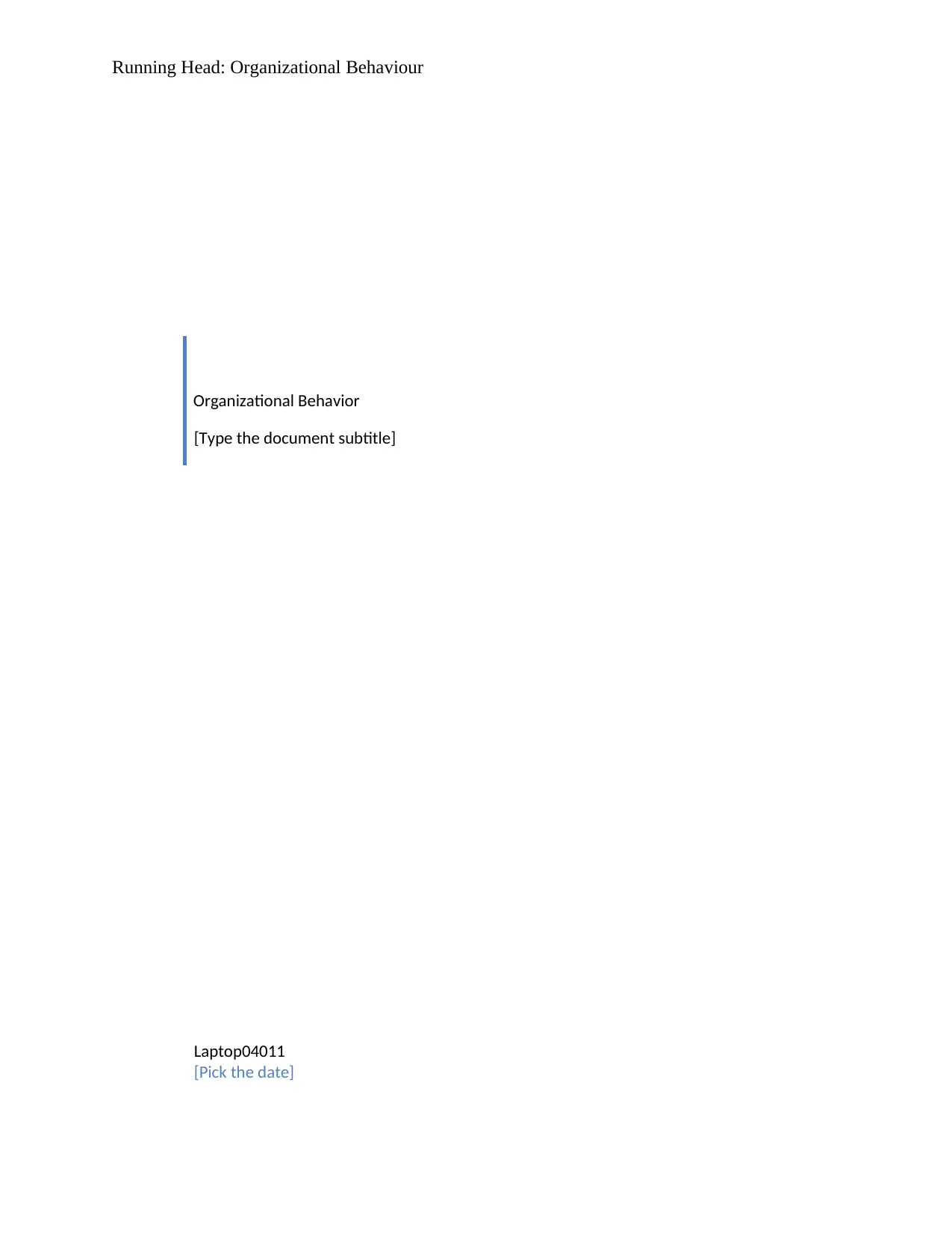
Running Head: Organizational Behaviour
Organizational Behavior
[Type the document subtitle]
Laptop04011
[Pick the date]
Organizational Behavior
[Type the document subtitle]
Laptop04011
[Pick the date]
Paraphrase This Document
Need a fresh take? Get an instant paraphrase of this document with our AI Paraphraser
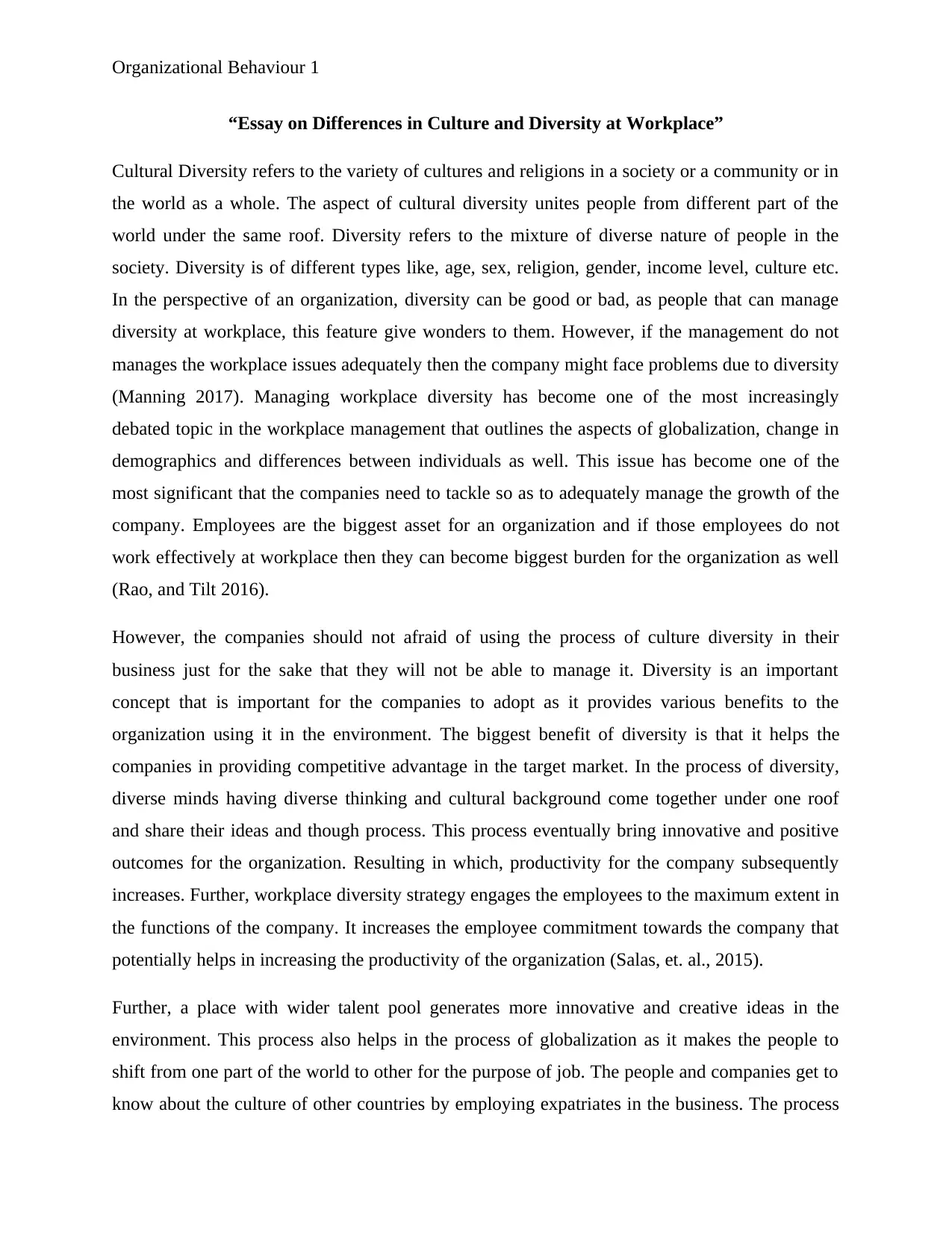
Organizational Behaviour 1
“Essay on Differences in Culture and Diversity at Workplace”
Cultural Diversity refers to the variety of cultures and religions in a society or a community or in
the world as a whole. The aspect of cultural diversity unites people from different part of the
world under the same roof. Diversity refers to the mixture of diverse nature of people in the
society. Diversity is of different types like, age, sex, religion, gender, income level, culture etc.
In the perspective of an organization, diversity can be good or bad, as people that can manage
diversity at workplace, this feature give wonders to them. However, if the management do not
manages the workplace issues adequately then the company might face problems due to diversity
(Manning 2017). Managing workplace diversity has become one of the most increasingly
debated topic in the workplace management that outlines the aspects of globalization, change in
demographics and differences between individuals as well. This issue has become one of the
most significant that the companies need to tackle so as to adequately manage the growth of the
company. Employees are the biggest asset for an organization and if those employees do not
work effectively at workplace then they can become biggest burden for the organization as well
(Rao, and Tilt 2016).
However, the companies should not afraid of using the process of culture diversity in their
business just for the sake that they will not be able to manage it. Diversity is an important
concept that is important for the companies to adopt as it provides various benefits to the
organization using it in the environment. The biggest benefit of diversity is that it helps the
companies in providing competitive advantage in the target market. In the process of diversity,
diverse minds having diverse thinking and cultural background come together under one roof
and share their ideas and though process. This process eventually bring innovative and positive
outcomes for the organization. Resulting in which, productivity for the company subsequently
increases. Further, workplace diversity strategy engages the employees to the maximum extent in
the functions of the company. It increases the employee commitment towards the company that
potentially helps in increasing the productivity of the organization (Salas, et. al., 2015).
Further, a place with wider talent pool generates more innovative and creative ideas in the
environment. This process also helps in the process of globalization as it makes the people to
shift from one part of the world to other for the purpose of job. The people and companies get to
know about the culture of other countries by employing expatriates in the business. The process
“Essay on Differences in Culture and Diversity at Workplace”
Cultural Diversity refers to the variety of cultures and religions in a society or a community or in
the world as a whole. The aspect of cultural diversity unites people from different part of the
world under the same roof. Diversity refers to the mixture of diverse nature of people in the
society. Diversity is of different types like, age, sex, religion, gender, income level, culture etc.
In the perspective of an organization, diversity can be good or bad, as people that can manage
diversity at workplace, this feature give wonders to them. However, if the management do not
manages the workplace issues adequately then the company might face problems due to diversity
(Manning 2017). Managing workplace diversity has become one of the most increasingly
debated topic in the workplace management that outlines the aspects of globalization, change in
demographics and differences between individuals as well. This issue has become one of the
most significant that the companies need to tackle so as to adequately manage the growth of the
company. Employees are the biggest asset for an organization and if those employees do not
work effectively at workplace then they can become biggest burden for the organization as well
(Rao, and Tilt 2016).
However, the companies should not afraid of using the process of culture diversity in their
business just for the sake that they will not be able to manage it. Diversity is an important
concept that is important for the companies to adopt as it provides various benefits to the
organization using it in the environment. The biggest benefit of diversity is that it helps the
companies in providing competitive advantage in the target market. In the process of diversity,
diverse minds having diverse thinking and cultural background come together under one roof
and share their ideas and though process. This process eventually bring innovative and positive
outcomes for the organization. Resulting in which, productivity for the company subsequently
increases. Further, workplace diversity strategy engages the employees to the maximum extent in
the functions of the company. It increases the employee commitment towards the company that
potentially helps in increasing the productivity of the organization (Salas, et. al., 2015).
Further, a place with wider talent pool generates more innovative and creative ideas in the
environment. This process also helps in the process of globalization as it makes the people to
shift from one part of the world to other for the purpose of job. The people and companies get to
know about the culture of other countries by employing expatriates in the business. The process
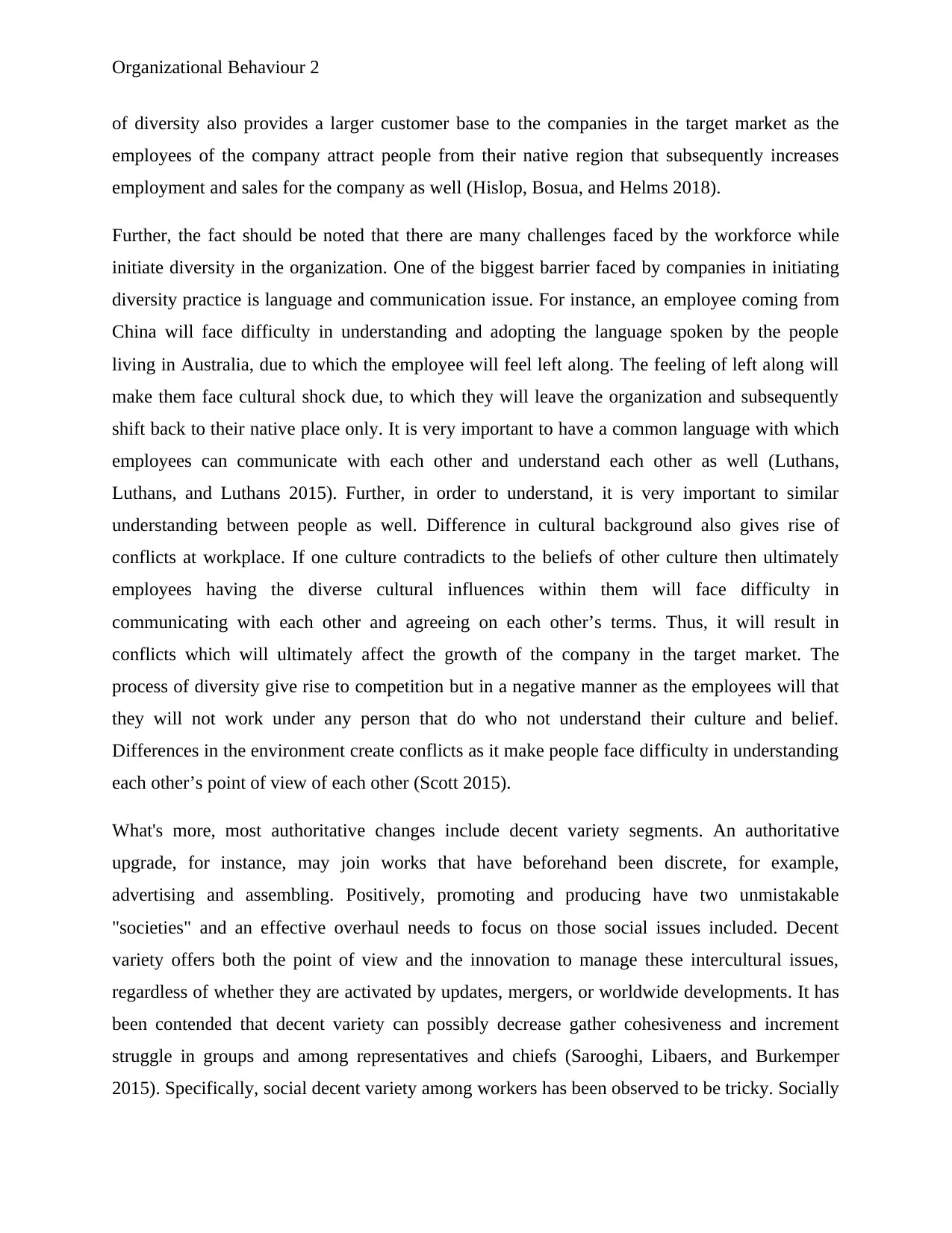
Organizational Behaviour 2
of diversity also provides a larger customer base to the companies in the target market as the
employees of the company attract people from their native region that subsequently increases
employment and sales for the company as well (Hislop, Bosua, and Helms 2018).
Further, the fact should be noted that there are many challenges faced by the workforce while
initiate diversity in the organization. One of the biggest barrier faced by companies in initiating
diversity practice is language and communication issue. For instance, an employee coming from
China will face difficulty in understanding and adopting the language spoken by the people
living in Australia, due to which the employee will feel left along. The feeling of left along will
make them face cultural shock due, to which they will leave the organization and subsequently
shift back to their native place only. It is very important to have a common language with which
employees can communicate with each other and understand each other as well (Luthans,
Luthans, and Luthans 2015). Further, in order to understand, it is very important to similar
understanding between people as well. Difference in cultural background also gives rise of
conflicts at workplace. If one culture contradicts to the beliefs of other culture then ultimately
employees having the diverse cultural influences within them will face difficulty in
communicating with each other and agreeing on each other’s terms. Thus, it will result in
conflicts which will ultimately affect the growth of the company in the target market. The
process of diversity give rise to competition but in a negative manner as the employees will that
they will not work under any person that do who not understand their culture and belief.
Differences in the environment create conflicts as it make people face difficulty in understanding
each other’s point of view of each other (Scott 2015).
What's more, most authoritative changes include decent variety segments. An authoritative
upgrade, for instance, may join works that have beforehand been discrete, for example,
advertising and assembling. Positively, promoting and producing have two unmistakable
"societies" and an effective overhaul needs to focus on those social issues included. Decent
variety offers both the point of view and the innovation to manage these intercultural issues,
regardless of whether they are activated by updates, mergers, or worldwide developments. It has
been contended that decent variety can possibly decrease gather cohesiveness and increment
struggle in groups and among representatives and chiefs (Sarooghi, Libaers, and Burkemper
2015). Specifically, social decent variety among workers has been observed to be tricky. Socially
of diversity also provides a larger customer base to the companies in the target market as the
employees of the company attract people from their native region that subsequently increases
employment and sales for the company as well (Hislop, Bosua, and Helms 2018).
Further, the fact should be noted that there are many challenges faced by the workforce while
initiate diversity in the organization. One of the biggest barrier faced by companies in initiating
diversity practice is language and communication issue. For instance, an employee coming from
China will face difficulty in understanding and adopting the language spoken by the people
living in Australia, due to which the employee will feel left along. The feeling of left along will
make them face cultural shock due, to which they will leave the organization and subsequently
shift back to their native place only. It is very important to have a common language with which
employees can communicate with each other and understand each other as well (Luthans,
Luthans, and Luthans 2015). Further, in order to understand, it is very important to similar
understanding between people as well. Difference in cultural background also gives rise of
conflicts at workplace. If one culture contradicts to the beliefs of other culture then ultimately
employees having the diverse cultural influences within them will face difficulty in
communicating with each other and agreeing on each other’s terms. Thus, it will result in
conflicts which will ultimately affect the growth of the company in the target market. The
process of diversity give rise to competition but in a negative manner as the employees will that
they will not work under any person that do who not understand their culture and belief.
Differences in the environment create conflicts as it make people face difficulty in understanding
each other’s point of view of each other (Scott 2015).
What's more, most authoritative changes include decent variety segments. An authoritative
upgrade, for instance, may join works that have beforehand been discrete, for example,
advertising and assembling. Positively, promoting and producing have two unmistakable
"societies" and an effective overhaul needs to focus on those social issues included. Decent
variety offers both the point of view and the innovation to manage these intercultural issues,
regardless of whether they are activated by updates, mergers, or worldwide developments. It has
been contended that decent variety can possibly decrease gather cohesiveness and increment
struggle in groups and among representatives and chiefs (Sarooghi, Libaers, and Burkemper
2015). Specifically, social decent variety among workers has been observed to be tricky. Socially
⊘ This is a preview!⊘
Do you want full access?
Subscribe today to unlock all pages.

Trusted by 1+ million students worldwide
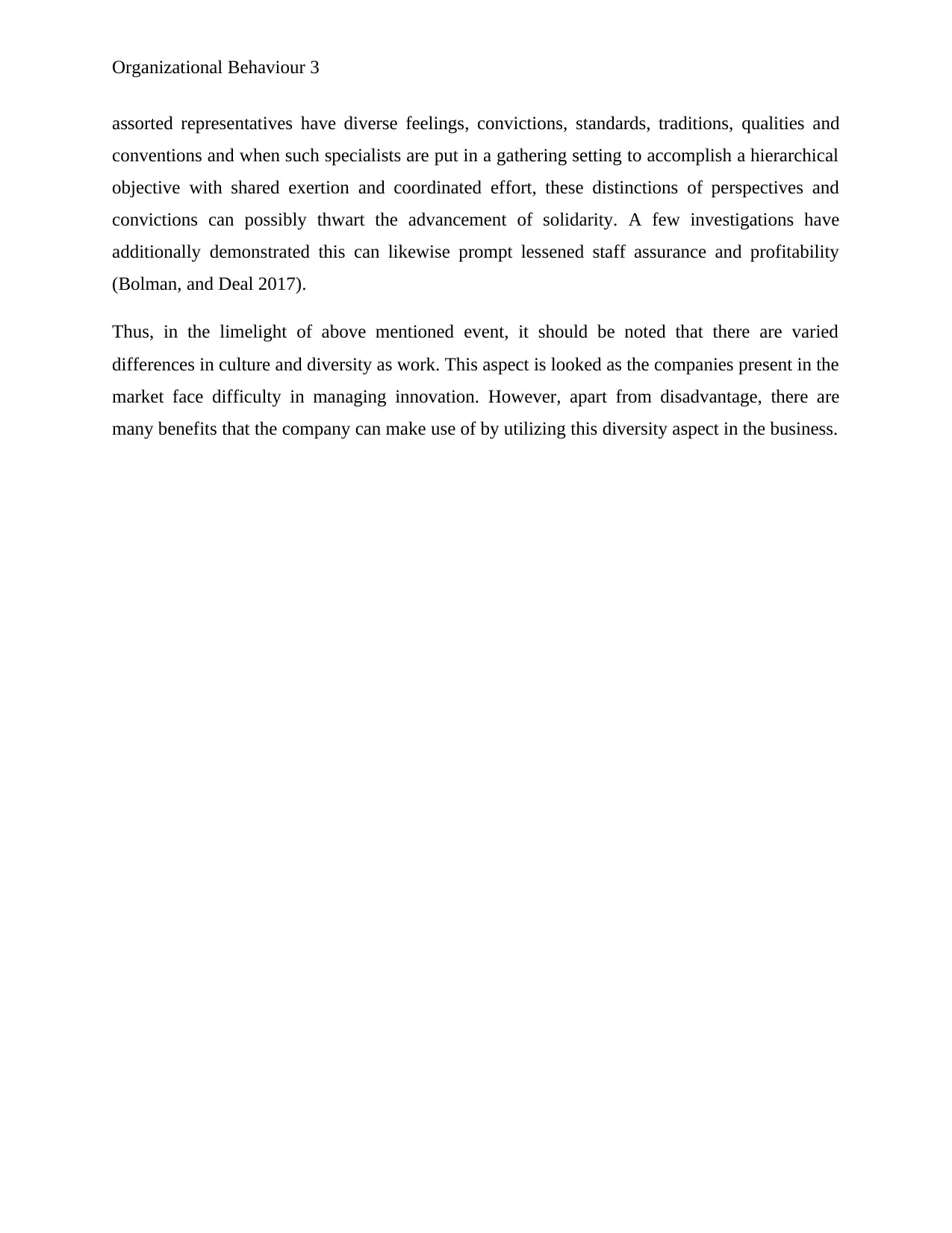
Organizational Behaviour 3
assorted representatives have diverse feelings, convictions, standards, traditions, qualities and
conventions and when such specialists are put in a gathering setting to accomplish a hierarchical
objective with shared exertion and coordinated effort, these distinctions of perspectives and
convictions can possibly thwart the advancement of solidarity. A few investigations have
additionally demonstrated this can likewise prompt lessened staff assurance and profitability
(Bolman, and Deal 2017).
Thus, in the limelight of above mentioned event, it should be noted that there are varied
differences in culture and diversity as work. This aspect is looked as the companies present in the
market face difficulty in managing innovation. However, apart from disadvantage, there are
many benefits that the company can make use of by utilizing this diversity aspect in the business.
assorted representatives have diverse feelings, convictions, standards, traditions, qualities and
conventions and when such specialists are put in a gathering setting to accomplish a hierarchical
objective with shared exertion and coordinated effort, these distinctions of perspectives and
convictions can possibly thwart the advancement of solidarity. A few investigations have
additionally demonstrated this can likewise prompt lessened staff assurance and profitability
(Bolman, and Deal 2017).
Thus, in the limelight of above mentioned event, it should be noted that there are varied
differences in culture and diversity as work. This aspect is looked as the companies present in the
market face difficulty in managing innovation. However, apart from disadvantage, there are
many benefits that the company can make use of by utilizing this diversity aspect in the business.
Paraphrase This Document
Need a fresh take? Get an instant paraphrase of this document with our AI Paraphraser
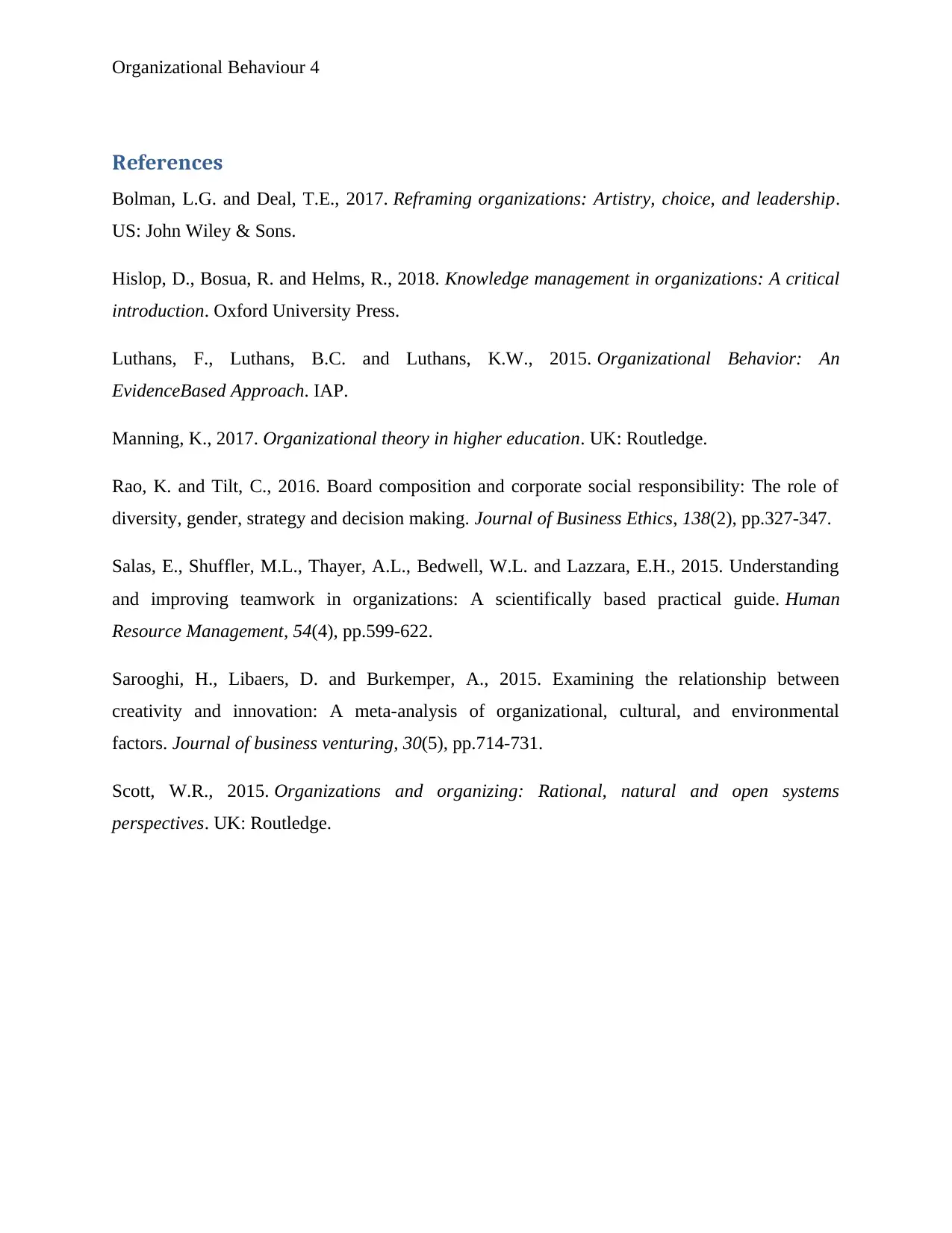
Organizational Behaviour 4
References
Bolman, L.G. and Deal, T.E., 2017. Reframing organizations: Artistry, choice, and leadership.
US: John Wiley & Sons.
Hislop, D., Bosua, R. and Helms, R., 2018. Knowledge management in organizations: A critical
introduction. Oxford University Press.
Luthans, F., Luthans, B.C. and Luthans, K.W., 2015. Organizational Behavior: An
EvidenceBased Approach. IAP.
Manning, K., 2017. Organizational theory in higher education. UK: Routledge.
Rao, K. and Tilt, C., 2016. Board composition and corporate social responsibility: The role of
diversity, gender, strategy and decision making. Journal of Business Ethics, 138(2), pp.327-347.
Salas, E., Shuffler, M.L., Thayer, A.L., Bedwell, W.L. and Lazzara, E.H., 2015. Understanding
and improving teamwork in organizations: A scientifically based practical guide. Human
Resource Management, 54(4), pp.599-622.
Sarooghi, H., Libaers, D. and Burkemper, A., 2015. Examining the relationship between
creativity and innovation: A meta-analysis of organizational, cultural, and environmental
factors. Journal of business venturing, 30(5), pp.714-731.
Scott, W.R., 2015. Organizations and organizing: Rational, natural and open systems
perspectives. UK: Routledge.
References
Bolman, L.G. and Deal, T.E., 2017. Reframing organizations: Artistry, choice, and leadership.
US: John Wiley & Sons.
Hislop, D., Bosua, R. and Helms, R., 2018. Knowledge management in organizations: A critical
introduction. Oxford University Press.
Luthans, F., Luthans, B.C. and Luthans, K.W., 2015. Organizational Behavior: An
EvidenceBased Approach. IAP.
Manning, K., 2017. Organizational theory in higher education. UK: Routledge.
Rao, K. and Tilt, C., 2016. Board composition and corporate social responsibility: The role of
diversity, gender, strategy and decision making. Journal of Business Ethics, 138(2), pp.327-347.
Salas, E., Shuffler, M.L., Thayer, A.L., Bedwell, W.L. and Lazzara, E.H., 2015. Understanding
and improving teamwork in organizations: A scientifically based practical guide. Human
Resource Management, 54(4), pp.599-622.
Sarooghi, H., Libaers, D. and Burkemper, A., 2015. Examining the relationship between
creativity and innovation: A meta-analysis of organizational, cultural, and environmental
factors. Journal of business venturing, 30(5), pp.714-731.
Scott, W.R., 2015. Organizations and organizing: Rational, natural and open systems
perspectives. UK: Routledge.
1 out of 5
Related Documents
Your All-in-One AI-Powered Toolkit for Academic Success.
+13062052269
info@desklib.com
Available 24*7 on WhatsApp / Email
![[object Object]](/_next/static/media/star-bottom.7253800d.svg)
Unlock your academic potential
Copyright © 2020–2025 A2Z Services. All Rights Reserved. Developed and managed by ZUCOL.




